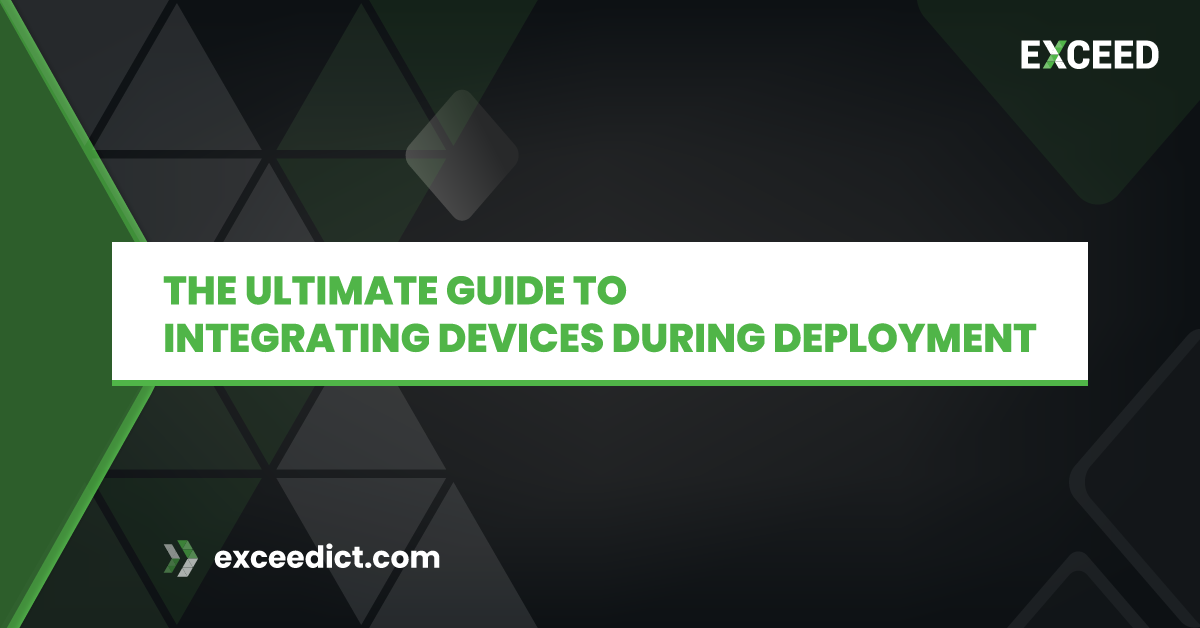
Everything you need to know about Seamless Integration for device during deployment
 As technology continues to advance, businesses and organisations are investing heavily in digital transformation to stay ahead of the competition. However, deploying new devices and technologies can be a challenging task, especially when it comes to integrating them with existing systems. Seamless integration of devices is crucial to ensure that all systems work in harmony and are optimised for maximum performance.
As technology continues to advance, businesses and organisations are investing heavily in digital transformation to stay ahead of the competition. However, deploying new devices and technologies can be a challenging task, especially when it comes to integrating them with existing systems. Seamless integration of devices is crucial to ensure that all systems work in harmony and are optimised for maximum performance.
In this guide, we will explore everything you need to know about seamless integration during deployment. We will cover essential strategies, tools, and best practices to help you achieve successful device integration.
Understanding Seamless Integration:
Definition of Seamless Integration
Seamless integration refers to the process of combining different systems, technologies, or processes into a cohesive and functional whole, with the aim of achieving a seamless flow of information and processes across different platforms. The primary goal of seamless integration is to create an ecosystem where different components work together as a unified system, without the need for complex and time-consuming manual interventions.
Benefits of Seamless Integration:
-
- Improved Efficiency: Seamless integration leads to a more efficient system by automating workflows and reducing the need for manual interventions. This saves time, minimises errors and increases productivity.
- Increased Collaboration: Seamless integration fosters collaboration across different departments, teams, and systems by allowing them to share information in real-time. This reduces silos, enhances communication and leads to better decision-making.
- Cost Savings: Seamless integration helps businesses save costs by reducing the need for manual interventions, minimising errors, and optimising resource utilisation. This leads to increased profitability and better resource allocation.
- Enhanced Customer Experience: Seamless integration allows businesses to provide a better customer experience by offering a cohesive and personalised experience across different touchpoints. This improves customer satisfaction, loyalty and retention.
- Scalability: Seamless integration allows businesses to scale up their operations without the need for significant changes in the underlying systems. This makes it easier to accommodate growth and adapt to changing market conditions.
Importance of Seamless Integration during Deployment:
-
- Ensures Maximum Performance: Seamless integration ensures maximum performance by eliminating the need for manual interventions and minimising errors. This leads to faster and more accurate processing of data, resulting in improved system performance and reliability.
- Enhances User Experience: Seamless integration enhances user experience by providing a cohesive and consistent experience across different touchpoints. This leads to increased satisfaction, loyalty, and retention among users.
- Increases Efficiency and Productivity: Seamless integration increases efficiency and productivity by automating workflows and reducing the need for manual interventions. This leads to faster processing of data, improved resource utilisation, and higher productivity levels among employees.
Challenges of Device Integration during Deployment:
 Device integration during deployment can pose several challenges, including:
Device integration during deployment can pose several challenges, including:
-
- Compatibility Issues: One of the primary challenges of device integration during deployment is compatibility issues between different devices and systems. Different devices and systems may use different protocols, interfaces, and standards, which can make it difficult to integrate them seamlessly. This can lead to delays, errors, and reduced system performance.
- Data Security Concerns: Another major challenge of device integration during deployment is data security concerns. Integrating different devices and systems can increase the risk of data breaches, unauthorised access, and other security threats. This can compromise the confidentiality, integrity, and availability of sensitive data.
- Integration Complexity: Integrating different devices and systems can be a complex and time-consuming process. It requires careful planning, coordination, and testing to ensure that all components work seamlessly together. Any errors or issues that arise during the integration process can cause delays, increase costs, and reduce the effectiveness of the system.
Overall, device integration during deployment requires careful consideration of these challenges to ensure that the integration process is successful and the system operates effectively and securely.
Strategies for Seamless Integration during Deployment:
-
- Conducting a Thorough Analysis: Before integrating different devices and systems, it is important to conduct a thorough analysis of their capabilities, protocols, interfaces, and standards. This will help to identify potential compatibility issues, security risks, and other challenges that may arise during the integration process.
- Creating a Comprehensive Integration Plan: Based on the analysis, it is important to create a comprehensive integration plan that outlines the steps involved in the integration process. This should include timelines, milestones, responsibilities, and contingency plans to address any issues that arise during the process.
- Ensuring Compatibility: To ensure compatibility between different devices and systems, it may be necessary to use middleware, APIs, or other integration tools. These tools can help to translate data between different formats, protocols, and interfaces, and ensure that the devices and systems can communicate seamlessly.
- Prioritising Security: To ensure data security during device integration, it is important to prioritise security measures such as access controls, encryption, and data backup. Security protocols should be implemented at every stage of the integration process, from planning and design to testing and deployment.
- Testing and Validation: Once the integration is complete, it is important to conduct thorough testing and validation to ensure that the system is functioning as expected. This may include functional testing, performance testing, and security testing to identify any issues or vulnerabilities that need to be addressed.
Tools for Successful Device Integration:
-
- Cloud-Based Integration Platforms: Cloud-based integration platforms are solutions that enable organisations to integrate different devices and systems in a cloud-based environment. These platforms provide a scalable, flexible, and cost-effective way to integrate different devices and systems, while also providing data security and compliance features.
- Application Programming Interfaces (APIs): APIs are software interfaces that enable different applications to communicate and share data with each other. APIs can be used to integrate different devices and systems, allowing them to communicate seamlessly and exchange data in real-time.
- Middleware Solutions: Middleware solutions are software that sits between different devices and systems, acting as a bridge to facilitate communication and data exchange. Middleware solutions can translate data between different formats, protocols, and interfaces, making it possible for different devices and systems to communicate effectively.
- Data Integration Tools: Data integration tools are software solutions that enable organisations to extract, transform, and load data from different sources into a single destination. These tools can be used to integrate data from different devices and systems, enabling organisations to analyse and gain insights from large volumes of data.
Best Practices for Device Integration:
-
 Involving All Stakeholders: Device integration involves multiple stakeholders, including IT teams, developers, vendors, and end-users. To ensure the integration process is successful, it is important to involve all stakeholders in the planning and implementation process. This helps to ensure that everyone understands the goals and objectives of the integration and can provide valuable input and feedback.
Involving All Stakeholders: Device integration involves multiple stakeholders, including IT teams, developers, vendors, and end-users. To ensure the integration process is successful, it is important to involve all stakeholders in the planning and implementation process. This helps to ensure that everyone understands the goals and objectives of the integration and can provide valuable input and feedback.- Regular Communication and Collaboration: Communication and collaboration are critical for successful device integration. Regular meetings, updates, and status reports can help to ensure that all stakeholders are aware of the progress and any issues that arise. This can help to identify and address issues before they become more significant problems.
- Prioritising Data Security: Data security should be a top priority during device integration. All stakeholders should be aware of the security risks and measures that are in place to protect sensitive data. This includes implementing access controls, encryption, and other security protocols to protect against data breaches and other security threats.
- Implementing a Continuous Integration Approach: Continuous integration is a software development practice that involves integrating code changes frequently and automatically. This approach can be applied to device integration to ensure that new devices and systems are integrated seamlessly and quickly. This approach can help to reduce errors, improve system performance, and ensure that the integration process is as efficient as possible.
- Conducting Regular Testing and Validation: Regular testing and validation are critical to ensuring that the integrated system is functioning as expected. This includes functional testing, performance testing, and security testing to identify any issues or vulnerabilities that need to be addressed. Regular testing and validation can help to ensure that the system is reliable, secure, and meets the needs of the organisation.
FAQs about Device Integration:
What is seamless integration?
Seamless integration refers to the process of integrating different devices and systems so that they work together seamlessly and without interruption. It involves connecting various devices and systems to ensure that they communicate effectively, share data and resources, and function as a single unit.
The goal of seamless integration is to create a unified and efficient system that enhances productivity, maximises performance, and provides a better user experience.
Why is seamless integration important during deployment?
Seamless integration is important during deployment because it ensures that different devices and systems work together effectively, reducing the risk of errors, system downtime, and performance issues. This is especially important in mission-critical systems where downtime can have serious consequences.
Seamless integration can also improve user experience by making it easier to access and use different systems, applications, and devices.
What are the challenges of device integration during deployment?
The challenges of device integration during deployment include compatibility issues, data security concerns, and integration complexity. Different devices and systems may use different protocols, interfaces, and data formats, making it difficult to connect them seamlessly.
Data security concerns also need to be addressed to ensure that sensitive data is protected during the integration process. Integration complexity can also be a challenge, especially when dealing with large volumes of data or complex systems.
What are the best practices for successful device integration?
Best practices for successful device integration include involving all stakeholders, regular communication and collaboration, prioritising data security, implementing a continuous integration approach, and conducting regular testing and validation.
Involving all stakeholders ensures that everyone understands the goals and objectives of the integration, while regular communication and collaboration help to identify and address issues early on.
Prioritising data security ensures that sensitive data is protected, while implementing a continuous integration approach ensures that new devices and systems are integrated seamlessly and quickly. Regular testing and validation help to ensure that the integrated system is functioning as expected.
What tools are available for seamless device integration?
There are several tools available for seamless device integration, including cloud-based integration platforms, application programming interfaces (APIs), middleware solutions, and data integration tools. Cloud-based integration platforms provide a scalable, flexible, and cost-effective way to integrate different devices and systems, while APIs enable different applications to communicate and share data with each other.
Middleware solutions act as a bridge to facilitate communication and data exchange, while data integration tools enable organisations to extract, transform, and load data from different sources into a single destination. The choice of device integration tools depends on the specific needs and requirements of the organisation.
In conclusion, seamless integration of devices during deployment is crucial for optimising performance, enhancing user experience, and increasing productivity. By understanding the challenges, strategies, tools, and best practices for device integration, businesses and organisations can successfully deploy new technologies and systems that work in harmony with existing ones.
Remember to prioritise data security, involve all stakeholders, and conduct regular testing and validation to ensure that all systems are optimised for maximum performance. With the right tools and approach, seamless integration of devices can be achieved, leading to a more efficient and productive workplace.
You may also like to know more about
- The Roadmap to Success: A Guide to Device Deployment Planning.
- Stay Protected: The Essential Guide to Secure Device Deployment.
- Save Money and Time: The Ultimate Guide to Cost-Effective Device Deployment.
- The Best Enterprise Device Deployment Solutions & Streamline Your Business.
- The Ultimate Guide to Device Deployment.
Stay connected with EXCEED ICT
Stay connected with EXCEED ICT by joining our social networks (given at footer). Get the latest updates, news, and tips for enterprise device deployment. Follow us on Twitter, Facebook, and LinkedIn for the best enterprise device deployment solutions.
Help us to improve our enterprise device deployment solutions by rating us on Google Maps. Your feedback and comments are valuable to us and will be used to make our services even better.
Thanks visiting.



